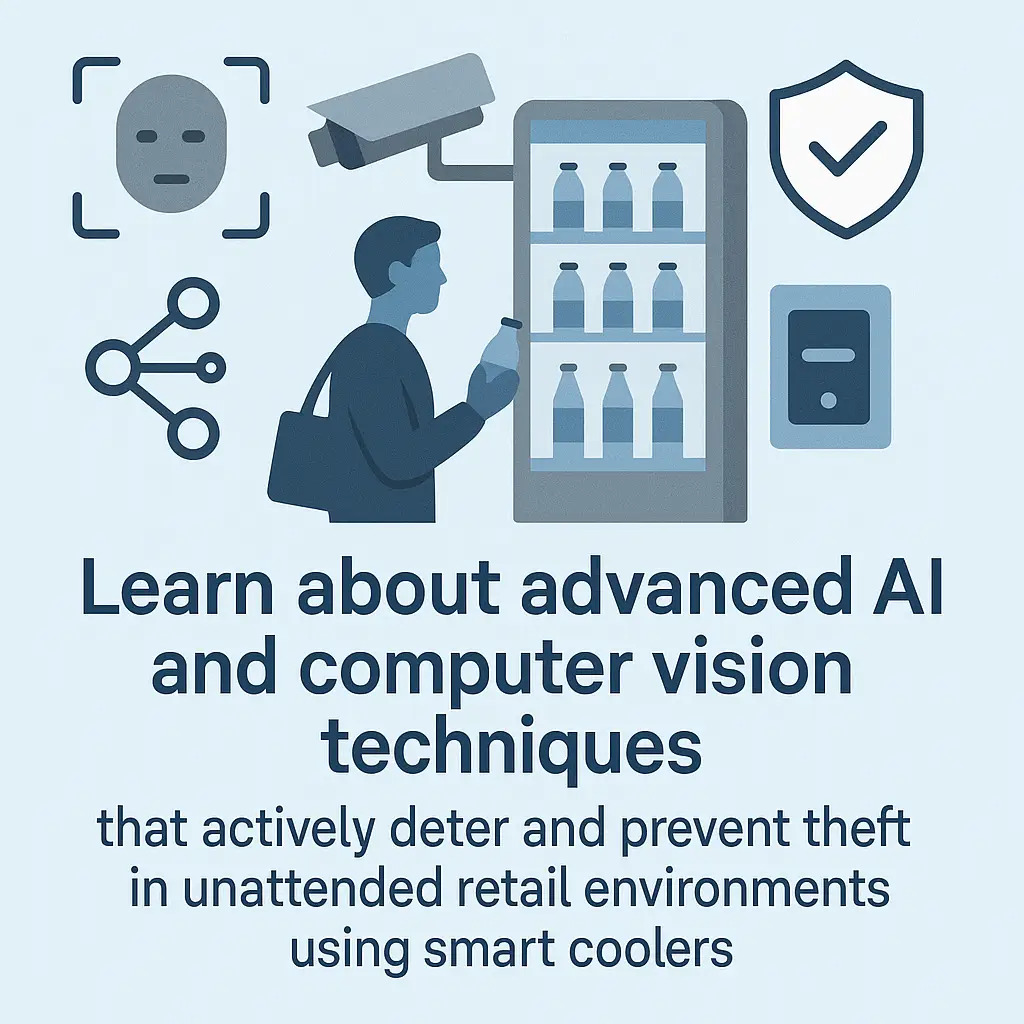Preventing Theft in Unattended Retail with AI
Learn about advanced AI and computer vision techniques that actively deter and prevent theft in unattended retail environments using smart coolers.
Back to AI Vending Coolers ResourcesLearn about advanced AI and computer vision techniques that actively deter and prevent theft in unattended retail environments using smart coolers.
Back to AI Vending Coolers ResourcesArtificial intelligence, particularly through computer vision and smart coolers, provides a robust defense against theft in self-service retail settings, ensuring both security and convenience.
![]() Real-time monitoring and anomaly detection deter illicit activities.
Real-time monitoring and anomaly detection deter illicit activities.
![]() Automated alerts and loss prevention measures reduce inventory shrinkage.
Automated alerts and loss prevention measures reduce inventory shrinkage.
![]() Enhanced security builds trust for customers in self-checkout environments.
Enhanced security builds trust for customers in self-checkout environments.

The rise of unattended retail and micro markets has brought unprecedented convenience to consumers, allowing 24/7 access to products without human supervision. However, this model also presents unique challenges, particularly concerning theft and inventory loss. Artificial Intelligence (AI) and advanced computer vision technologies are revolutionizing how these environments are secured, transforming passive surveillance into active loss prevention.
AI-powered vending coolers leverage an array of sensors and high-definition cameras to continuously monitor customer interactions. These systems are trained on vast datasets to recognize normal purchasing behavior versus suspicious activities. For instance, if a customer selects an item but then attempts to re-seal the cooler without completing payment, the AI can immediately flag this action. This real-time detection is crucial because it allows for intervention or flags the incident for review, significantly reducing shrinkage.
The core of AI's effectiveness lies in its ability to process complex visual data and identify patterns that humans might miss. Computer vision algorithms can accurately track items as they are removed from shelves, cross-referencing these actions with payment confirmations. If a discrepancy arises, the system can initiate various responses, from triggering an audible alarm to denying subsequent transactions until the issue is resolved. This proactive approach not only prevents current theft attempts but also acts as a powerful deterrent for future misconduct. More details on these security features can be found by exploring AI Cooler Security and Loss Prevention.
Moreover, AI systems often integrate with existing security infrastructure, enhancing overall facility safety. They can track individuals within the retail space, analyze their movements, and identify unusual loitering or attempts to tamper with equipment. This comprehensive oversight is essential for businesses that rely on self-service models, allowing them to scale operations without proporcional increases in security staffing.
Beyond direct theft prevention, AI also contributes to operational efficiency. By accurately tracking inventory in real-time, these systems provide valuable data on stock levels, popular products, and potential restocking needs. This minimizes manual audits and ensures that products are always available, which indirectly combats theft arising from out-of-stock items being 'grabbed' by frustrated customers. For insights into how inventory tracking works, visit Inventory Tracking with AI Coolers.
For businesses, implementing AI vending coolers translates into reduced losses, improved profitability, and the ability to instill greater trust in the self-service model. Customers benefit from a seamless and secure shopping experience, knowing that the system is fair and reliable. As unattended retail continues to grow, AI-powered security solutions will be indispensable for creating scalable, trustworthy, and profitable operations. Understanding the foundational technology can be further explored in How Smart Vending Coolers Work.
AI uses computer vision to monitor customer behavior, identify suspicious actions, and automate alerts or even deny transactions when theft is detected, often through smart coolers.
Common methods include 'grab-and-go' without payment, product swapping, or manipulating payment systems. AI helps mitigate these risks.
Yes, advanced AI algorithms are trained to recognize normal purchasing patterns versus activities indicative of theft, such as removing items without initiating payment.
Features often include high-resolution cameras, weight sensors in shelving, motion detectors, and advanced software that processes data in real-time to detect anomalies.
While highly effective, performance can vary based on store layout, lighting conditions, and the specific AI system's sophistication. Continuous optimization is key.
Many systems use payment methods for identity or track activity patterns, rather than explicit facial recognition, to maintain privacy while deterring theft.
Depending on the system, it might trigger an audible alert, send a notification to staff, flag the transaction, or even prevent the door from fully opening until payment is clear.
Modern AI systems are designed for ease of use, with setup often guided by providers. Maintenance typically involves software updates and occasional hardware checks.
ROI comes from reduced inventory shrinkage, increased profits, and the ability to operate unattended retail confidently without constant human supervision.
Yes, by enabling frictionless, self-service shopping, AI contributes to a faster, more convenient experience while ensuring a secure environment for all honest customers.